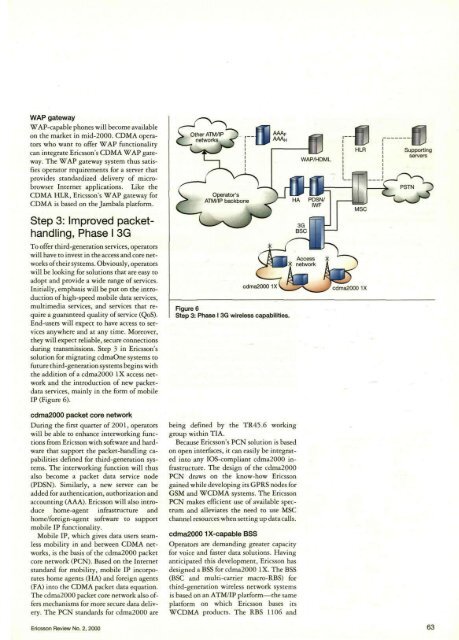ericssonhistory.com
ericssonhistory.com
ericssonhistory.com
- No tags were found...
Create successful ePaper yourself
Turn your PDF publications into a flip-book with our unique Google optimized e-Paper software.
WAP gatewayWAP-capable phones will be<strong>com</strong>e availableon the market in mid-2000. CDMA operatorswho want to offer WAP functionalitycan integrate Ericsson's CDMA WAP gateway.The WAP gateway system thus satisfiesoperator requirements for a server thatprovides standardized delivery of microbrowserInternet applications. Like theCDMA HLR, Ericsson's WAP gateway forCDMA is based on the Jambala platform.Step 3: Improved packethandling,Phase I 3GTo offer third-generation services, operatorswill have to invest in the access and core networksof their systems. Obviously, operatorswill be looking for solutions that are easy toadopt and provide a wide range of services.Initially, emphasis will be put on the introductionof high-speed mobile data services,multimedia services, and services that requirea guaranteed quality of service (QoS).End-users will expect to have access to servicesanywhere and at any time. Moreover,they will expect reliable, secure connectionsduring transmissions. Step 3 in Ericsson'ssolution for migrating cdmaOne systems tofuture third-generation systems begins withthe addition of a cdma2000 IX access networkand the introduction of new packetdataservices, mainly in the form of mobileIP (Figure 6).cdma2000 packet core networkDuring the first quarter of 2001, operatorswill be able to enhance interworking functionsfrom Ericsson with software and hardwarethat support the packet-handling capabilitiesdefined for third-generation systems.The interworking function will thusalso be<strong>com</strong>e a packet data service node(PDSN). Similarly, a new server can beadded for authentication, authorization andaccounting (AAA). Ericsson will also introducehome-agent infrastructure andhome/foreign-agent software to supportmobile IP functionality.Mobile IP, which gives data users seamlessmobility in and between CDMA networks,is the basis of the cdma2000 packetcore network (PCN). Based on the Internetstandard for mobility, mobile IP incorporateshome agents (HA) and foreign agents(FA) into the CDMA packet data equation.The cdma2000 packet core network also offersmechanisms for more secure data delivery.The PCN standards for cdma2000 areFigure 6Step 3: Phase I 3G wireless capabilities.being defined by the TR45.6 workinggroup within TIA.Because Ericsson's PCN solution is basedon open interfaces, it can easily be integratedinto any IOS-<strong>com</strong>pliant cdma2000 infrastructure.The design of the cdma2000PCN draws on the know-how Ericssongained while developing its GPRS nodes forGSM and WCDMA systems. The EricssonPCN makes efficient use of available spectrumand alleviates the need to use MSCchannel resources when setting up data calls.cdma2000 1X-capable BSSOperators are demanding greater capacityfor voice and faster data solutions. Havinganticipated this development, Ericsson hasdesigned a BSS for cdma2000 IX. The BSS(BSC and multi-carrier macro-RBS) forthird-generation wireless network systemsis based on an ATM/IP platform—the sameplatform on which Ericsson bases itsWCDMA products. The RBS 1106 andEricsson Review No. 2, 2000















